1.7 Exercise Problems
Q1. Name the parts of an angiosperm flower in which the development of male and female gametophyte take place.
Answer: In an angiosperm, the male gametes are developed within the anther. On the contrary, the female gametes are developed inside the ovules.
Q2. Differentiate between microsporogenesis and megasporogenesis. Which type of cell division occurs during these events? Name the structures formed at the end of these two events.
Answer: The important differences between microsporogenesis and megasporogenesis are mentioned below:
\(\begin{array}{|l|l|}
\hline \text { Microsporogenesis } & \text { Megasporogenesis } \\
\hline \begin{array}{l}
\text { It is the process in which a diploid microspore } \\
\text { mother cell undergoes meiosis to form haploid } \\
\text { microspores. }
\end{array} & \begin{array}{l}
\text { It is the process of formation of } \\
\text { haploid megaspores from the } \\
\text { diploid mother cell. }
\end{array} \\
\hline \text { Occurs inside pollen sacs. } & \text { Occurs inside ovules. } \\
\hline \text { Pollens are produced by microsporogenesis. } & \begin{array}{l}
\text { Embryo sacs are produced by } \\
\text { megasporogenesis. }
\end{array} \\
\hline \text { The arrangement of microspores is tetrahedral. } & \begin{array}{l}
\text { The arrangement of megaspores is } \\
\text { linear. }
\end{array} \\
\hline \text { All four microspores formed are functional. } & \begin{array}{l}
\text { Only one out of the four megaspores } \\
\text { formed is functional. }
\end{array} \\
\hline
\end{array}
\)
Meiotic cell division occurs during megasporogenesis and microsporogenesis. It is also known as reductional division that leads to the production of haploid gametes. The structures formed at the end of these events are:
Microsporogenesis – Pollen grain
Megasporogenesis – Embryo sac
Q3. Arrange the following terms in correct developmental sequence: Pollen grain, sporogenous tissue, microspore tetrad, pollen mother cell, male gametes.
Answer: The following is the correct developmental sequence: Sporogenous tissue \(\rightarrow\) pollen mother cell \(\rightarrow\) microspore tetrad \(\rightarrow\) pollen grain \(\rightarrow\) male gamete. When the microsporangium is developing, every cell of the sporogenous tissue serves as a pollen mother cell, giving rise to a microspore tetrad possessing four haploid microspores through the meiosis process (microsporogenesis). When the anthers mature, these microspores dissociate and develop into pollen grains. The pollen grains mature and give rise to male gametes.
Q4. With a neat, labelled diagram, describe the parts of a typical angiosperm ovule.
Answer: An ovule is a female megasporangium where the formation of megaspores takes place.
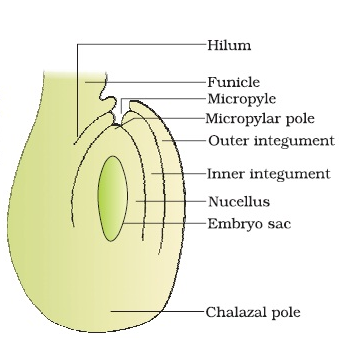
The various parts of an ovule are :
- Funicle – It is a stalk-like structure which represents the point of attachment of the ovule to the placenta of the ovary.
- Hilum – It is the point where the body of the ovule is attached to the funicle
- Integuments -They are the outer layers surrounding the ovule that provide protection to the developing embryo.
- Micropyle – It is a narrow pore formed by the projection of integuments. It marks the point where the pollen tube enters the ovule at the time of fertilization.
- Nucellus-It is a mass of the parenchymatous tissue surrounded by the integuments from the outside.
The nucellus provides nutrition to the developing embryo. The embryo sac is located inside the nucellus - Chalazal – It is the based swollen part of the nucellus from where the integuments originate.
Q5. What is meant by monosporic development of female gametophyte?
Answer: Monosporic development is the development of a female gametophyte from one functional megaspore. In angiosperms, a single diploid mother megaspore undergoes meiotic division to form four megaspores (haploid). Only one out of the four megaspores is functional, which forms a female gametophyte, while the rest of the three degenerate.
Q6. With a neat diagram, explain the 7-celled, 8-nucleate nature of female gametophyte.
Answer:

The female gametophyte is formed by the mitotic division of the mother megaspore. The megaspore divides mitotically thrice to form 8 nucleate embryo sacs. The process of formation of the 7-celled, 8-nucleate nature of female gametophyte is mentioned below:
- Two nuclei are formed after the cell undergoes the first mitotic division.
- These two nuclei move towards the micropylar end and the chalazal end, respectively.
- They divide and redivide to form an 8-nucleate stage.
- Consequently, there are four nuclei each on either end.
- At the micropylar end, three out of the four nuclei differentiate into an egg cell and synergids.
- At the chalazal end, three out of the four nuclei differentiate as antipodal cells.
- The remaining cells, each from either end move towards the centre and is known as polar nuclei. Therefore, on maturation, the female gametophyte looks like a 7-celled structure.
Q7. What are chasmogamous flowers? Can cross-pollination occur in cleistogamous flowers? Give reasons for your answer.
Answer: Chasmogamous flowers are flowers that have open petals such that the reproductive organs are exposed to allow cross-pollination. Cleistogamous flowers are small, closed flowers with unexposed reproductive organs. Therefore, they cannot undergo cross-pollination. However, they undergo self-pollination since the stigma and anther are present near each other.
Q8. Mention two strategies evolved to prevent self-pollination in flowers.
Answer: There are two strategies involved in preventing self-pollination in flowers:
- Dichogamy – It refers to the production of male and female reproductive organs at different times in order to prevent self-fertilization.
- Self-incompatibility – It is a genetically controlled mechanism in which pollen grains of a flower are unable to grow completely on the stigma of the same flower.
Q9. What is self-incompatibility? Why does self-pollination not lead to seed formation in self-incompatible species?
Answer: Self-incompatibility refers to a genetically controlled mechanism that prevents self-pollination and promotes cross-pollination in flowers. Self-pollination cannot lead to the formation of seeds in a self-incompatible species. This happens because the pollens are unable to fertilize the ovules that would develop into an embryo and hence form seeds.
Q10. What is bagging technique? How is it helpful in a plant breeding programme?
Answer: The bagging technique helps prevent fertilization of the stigma by any undesired pollen by covering the emasculated flower (flower whose anther is removed) with a polybag or butter paper. The bagging technique is beneficial in the plant breeding programme. In this, only desired pollens are made to fertilize the stigma in order to produce plants with desired characteristics.
Q11. What is triple fusion? Where and how does it take place? Name the nuclei involved in triple fusion.
Answer: Triple fusion occurs when a male gamete fuses with two polar nuclei within the embryo sac of flowering plants. The following events take place in triple fusion:
- The pollen grains get dusted on the stigma and germinate, giving rise to a pollen tube that enters the ovule.
- The pollen tube passes into one of the synergids and releases two male gametes.
- One out of the two gametes fuses with the egg nucleus and forms a zygote.
- The other gamete fuses with the two polar nuclei located in the central cell and forms a triploid endosperm nucleus.
The nuclei involved in triple fusion are:
- A male gamete nucleus
- Two polar nuclei
Q12. Why do you think a zygote is dormant for some time in a fertilized ovule?
Answer: The zygote remains inactive until the endosperm is formed as a result of triple fusion. The endosperm provides nutrition to the developing embryo and is formed from the primary endosperm cell that results from triple fusion.
Q.13. Differentiate between:
(a) Epicotyl and hypocotyl
(b) Coleoptile and coleorrhiza
(c) Integument and testa
(d) Perisperm and pericarp
Answer: (a)
\(\begin{array}{|l|l|}
\hline \text { Epicotyl } & \text { Hypocotyl } \\
\hline \begin{array}{l}
\text { Region of embryo above the } \\
\text { cotyledon. }
\end{array} & \text { Region of the embryo below the cotyledon. } \\
\hline \text { Terminates at the plumule. } & \text { Terminates at the cotyledonary node. } \\
\hline \begin{array}{l}
\text { Starts from the cotyledonary } \\
\text { node. }
\end{array} & \text { Starts from the radicle. } \\
\hline \begin{array}{l}
\text { Develops into the upper part of } \\
\text { the stem. }
\end{array} & \begin{array}{l}
\text { Develops into that part of the stem that develops } \\
\text { into roots. }
\end{array} \\
\hline \text { Elongates in epigeal germination. } & \text { Elongates in hypogeal germination. } \\
\hline
\end{array}
\)
(b)
\(\begin{array}{|l|l|}
\hline \text { Coleoptile } & \text { Coleorrhiza } \\
\hline \text { It is a protective sheath. } & \text { It is an undifferentiated sheath. } \\
\hline \begin{array}{l}
\text { Protects young shoot tip in cereals and } \\
\text { grass. }
\end{array} & \begin{array}{l}
\text { Protects the roots of a germinating grass or } \\
\text { cereal. }
\end{array} \\
\hline \text { Comes out of the soil. } & \text { Remains inside the soil. } \\
\hline \text { Covers the plumule. } & \text { Covers the root cap and radical. } \\
\hline \text { Breaks the seed coat and grows. } & \text { Breaks the seed coat and stops growth. } \\
\hline
\end{array}
\)
(c)
\(\begin{array}{|l|l|}
\hline \text { Integument } & \text { Testa } \\
\hline \text { Covers the ovule. } & \text { Outer covering of seed. } \\
\hline \text { The cells are living. } & \text { The cells are dead. } \\
\hline \text { Pre-fertilized structure. } & \text { Post-fertilized structure. } \\
\hline \text { Sclereids are absent. } & \text { Sclereids are present. } \\
\hline \text { One or two layered. } & \text { One layered. } \\
\hline
\end{array}
\)
(d)
\(\begin{array}{|l|l|}
\hline \text { Perisperm } & \text { Pericarp } \\
\hline \text { Part of a seed. } & \text { Part of a fruit. } \\
\hline \text { Usually dry. } & \text { Dry or fleshy. } \\
\hline \text { Present in only a few seeds. } & \text { Found in all fruits. } \\
\hline \text { Non-functional in seed. } & \text { Protects the fruit and helps in nutrition and dispersal. } \\
\hline
\end{array}
\)
Q14. Why is apple called a false fruit? Which part of the flower forms the fruit?
Answer: A false fruit is derived from some secondary parts and not from the ovary. Apple is derived from the thalamus and is hence called a false fruit.
Q15. What is meant by emasculation? When and why does a plant breeder employ this technique?
Answer: Emasculation refers to the removal of stamens from bisexual flowers before the maturation of the anther in order to avoid self-pollination in the flowers. This technique is employed when the breeder wants plants of desired characteristics. The flowers are bagged even before the anther matures. When the anther matures, the pollen grains are shed on the covered stigma and are allowed to pollinate with the flowers of the desired characteristics.
Q16. If one can induce parthenocarpy through the application of growth substances, which fruits would you select to induce parthenocarpy and why?
Answer: Parthenocarpy refers to the development of fruits without fertilization. Fruits devoid of seeds, such as watermelon and muskmelon, are in great demand. Therefore, these varieties will be developed by parthenocarpy.
Q17. Explain the role of tapetum in the formation of pollen grain walls.
Answer: Tapetum is the internal layer of microsporangium and plays an important role in the formation of pollen grain walls. It provides nutrition to the maturing pollen grains. Various amino acids, enzymes, and hormones are produced by tapetum cells that are essential for the maturation of pollen grains. Tapetum also forms the exine layer of pollen grains.
Q18. What is apomixis and what is its importance?
Answer: Apomixis is the process of seed formation without the occurrence of fertilization (the process of meiosis and syngamy, to be precise). It plays a vital role in the production of hybrid seeds. Apomixis inhibits the loss of desired characters in a hybrid. Also, the process of production of hybrid seeds through cultivation is expensive. Therefore, apomixis is used for the production of hybrid seeds.
Exemplar Section
VERY SHORT ANSWER TYPE QUESTIONS
Q1. Name the component cells of the ‘egg apparatus’ in an embryo sac.
Answer: Egg apparatus have three cells—one egg cell and two synergids.
Q2. Name the part of gynoecium that determines the compatible nature of pollen grain.
Answer: Compatible nature of pollen grain is determined by the stigma of carpel/ pistil.
Q3. Name the common function that cotyledons and nucellus perform.
Answer: Both cotyledons and nucellus provide nourishment.
Q4. Complete the following flow chart

Answer:

Q5. Indicate the stages where meiosis and mitosis occur (1, 2 or 3) in the flow chart.
\(\text { Megaspore mother cell } \xrightarrow{1} \text { Megaspores } \xrightarrow{2} \text { Embryo sac } \xrightarrow{3} \text { Egg }
\)
Answer:
\(
\text { Megaspore mother cell } \xrightarrow{\text { Meiosis }} \text { Megaspores } \xrightarrow{\text { Mitosis }} \text { Embryo sac }\xrightarrow{\text { Mitosis }} \text { Egg }
\)
Q6. In the diagram given below, show the path of a pollen tube from the pollen on the stigma into the embryo sac. Name the components of egg apparatus.
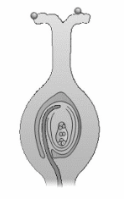
Answer: Components of egg apparatus: one egg cell and two synergids.

Q7. Name the parts of pistil which develop into fruit and seeds.
Answer: Ovary of pistil develops into fruit while ovules develop into seeds.
Q8. In case of polyembryony, if an embryo develops from the synergid and another from the nucellus which is haploid and which is diploid?
Answer: Synergid embryo is haploid and nucellar embryo is diploid.
Q9. Can an unfertilised, apomictic embryo sac give rise to a diploid embryo? If yes, then how?
Answer: Yes, if the embryo develops from the cells of nucellus or integument it will be diploid.
Q10. Which are the three cells found in a pollen grain when it is shed at the three celled stage?
Answer: One vegetative cell and two male gametes.
Q11. What is self-incompatibility?
Answer: The device to prevent inbreeding is self-incompatibility or self-sterility. This is a genetic mechanism and prevents self-pollen (from the same flower or other flowers of the same plant) from fertilising the ovules by inhibiting pollen germination or pollen tube growth in the pistil.
Q12. Name the type of pollination in self-incompatible plants.
Answer: Xenogamy
Q13. Draw the diagram of a mature embryo sac and show its 8-nucleate, 7-celled nature. Show the following parts: antipodals, synergids, egg, central cell, polar nuclei.
Answer:

Q14. Which is the triploid tissue in a fertilised ovule? How is the triploid condition achieved?
Answer: The triploid tissue in the ovule is the endosperm. Its triploid condition is . attained due to the fusion of two polar nuclei and one nucleus of male gamete (also referred to as triple fusion).
Q15. Are pollination and fertilisation necessary in apomixis? Give reasons.
Answer: No, they are not necessary. Apomixis is actually an alternative to sexual reproduction although the female sexual apparatus is used in the process. In apomicts, embryos can develop directly from the nucellus or synergid or egg. Therefore, there is no need for either pollination or fertilisation.
Q16. Identify the type of carpel with the help of diagrams given below:
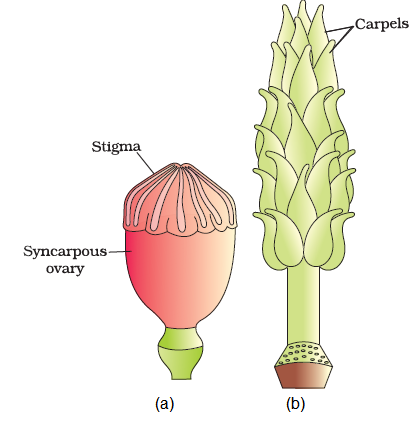
Answer:

Q17. How is pollination carried out in water plants?
Answer: Pollination by water is called hydrophily. Some examples of water pollinated plants are Vallisneria and Hydrilla (both are angiospermic hydrophytes) which grow in fresh water and several marine seagrasses such as Zostera. Not all aquatic plants use water for pollination. In a majority of aquatic plants such as water hyacinth and water lily, the flowers emerge above the level of water and pollinated by insects or wind as in most of the land plants.
Q18. What is the function of the two male gametes produced by each pollen grain in angiosperms.
Answer: After entering one of the synergids, the pollen tube releases the two male gametes into the cytoplasm of the synergid. One of the male gametes moves towards the egg cell or oosphere and fuses with its nucleus, thus completing the syngamy. This results in the formation of a diploid cell, the zygote. The other male gamete moves towards the two polar nuclei located in the central cell and fuses with them to produce a triploid primary endosperm nucleus (PEN).
SHORT ANSWER TYPE QUESTIONS
Q1. List three strategies that a bisexual chasmogamous flower can evolve to prevent self pollination (autogamy).
Answer: Flowering plants have developed many devices to discourage self-pollination and to encourage cross-pollination.
- First device: In some species, pollen release and stigma receptivity are not synchronised. Either the pollen is released before the stigma becomes receptive or stigma becomes receptive much before the release of pollen. This condition is called dichogamy in which stigma and anther matures at different time.
- Second device: In some species, the anther and stigma are placed at different positions so that the-pollen cannot come in contact with the stigma of the same flower. This condition is called heterostyly.
- Herkogamy: Non-transfer of pollen from anther to stigma of the same flower due to a mechanical barrier is present between anther and stigma. E.g.: Calotropis (Asclepiadaceae), Aristolochia, Gloriosa superba. The third device to prevent inbreeding is self-incompatibility or self-sterility. This is a genetic mechanism and prevents self-pollen (from the same flower or other flowers of the same plant) from fertilising the ovules by inhibiting pollen germination or pollen tube growth in the pistil.
Q2. Given below are the events that are observed in an artificial hybridization programme. Arrange them in the correct sequential order in which they are followed in the hybridisation programme.
(a) Re-bagging, (b) Selection of parents, (c) Bagging, (d) Dusting the pollen on stigma, (e) Emasculation, (f) Collection of pollen from male parent.
Answer: (b) Selection of parents ->(e) Emasculation -> (c) Bagging -> (f) Collection of pollen from male parent ->(d) Dusting the pollen on stigma ->(e) Rebagging.
Q3. Vivipary automatically limits the number of offsprings in a litter. How?
Answer: In viviparous animals (majority of mammals including human beings), the zygote develops into a young one inside the body of the female organism. After attaining a certain stage of growth, the young ones are delivered out of the body of the female organism. Vivipary automatically limits the number of offspring in a litter because female have limited space for the development of embryo.
Q4. Does self incompatibility impose any restrictions on autogamy? Give reasons and suggest the method of pollination in such plants.
Answer: Self-incompatibility imposes restriction to autogamy. The device to prevent inbreeding is self-incompatibility or self-sterility. This is a genetic mechanism and prevents self-pollen (from the same flower or other flowers of the same plant) from fertilising the ovules by inhibiting pollen germination or pollen tube growth in the pistil. Self-incompatiblity is overcome by mixed pollination.
Q5. In the given diagram, write the names of parts shown with lines.

Answer:
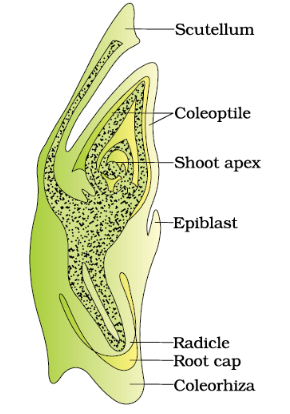
Q6. What is polyembryony and how can it be commercially exploited?
Answer: As in many Citrus and Mango varieties some of the nucellar cells surrounding the embryo sac start dividing, protrude into the embryo sac and develop into the embryos. In such species each ovule contains many embryos. Occurrence of more than one embryo in a seed is referred as polyembryony. If hybrids are made into apomicts, there is no segregation of characters in the hybrid progeny. Then the farmers can keep on using the hybrid seeds to raise new crop year after year and he does not have to buy hybrid seeds every year.
Q7. Are parthenocarpy and apomixis different phenomena? Discuss their benefits.
Hint: Yes, they are different. Parthenocarpy leads to development of seedless fruits. Apomixis leads to embryo development.
Answer: Yes, they are different. Parthenocarpy leads to development of seedless fruits. Apomixis leads to embryo development.
Q8. Why does the zygote begin to divide only after the division of Primary endosperm cell (PEC)?
Answer: The zygote needs nourishment during its development. As the mature, fertilised embryo sac offers very little nourishment to the zygote, the PEC divides and generates the endosperm tissue which nourishes the zygote. Hence, the zygote always divides after division of PEC.
Q9. The generative cell of a two-celled pollen divides in the pollen tube but not in a three-celled pollen. Give reasons.
Answer: In a 3-celled pollen, as the generative cell has already been divided and formed 2 male gametes, it will not divide again in the pollen tube. But in a 2-celled pollen, as the generative cell has not divided, it divides in the pollen tube.
Q10. In the figure given below label the following parts: male gametes, egg cell, polar nuclei, synergid and pollen tube.

Answer:
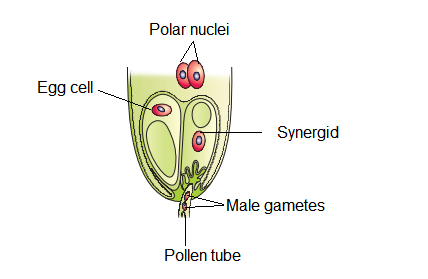
LONG ANSWER QUESTIONS
Q1. Starting with the zygote, draw the diagrams of the different stages of embryo development in a dicot.
Answer:
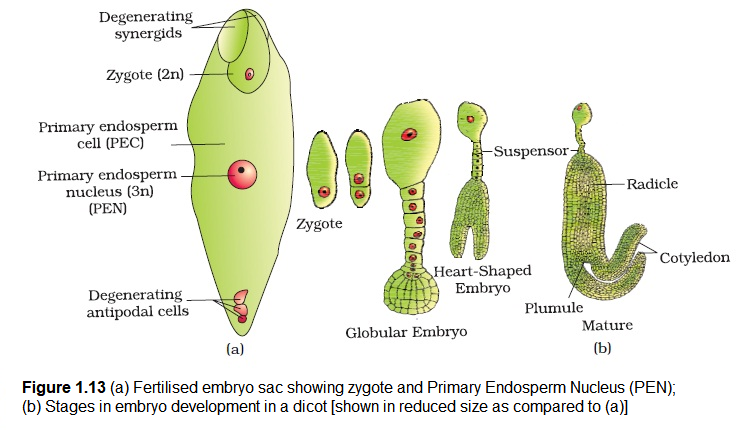
Q2. What are the possible types of pollinations in chasmogamous flowers. Give reasons.
Answer: A bisexual flower which normally open is called chasmogamous flower. Kinds of Pollination
- Autogamy: In this type, pollination is achieved within the same flower. Transfer of pollen grains from the anther to the stigma of the same flower. In a normal flower which opens and exposes the anthers and stigma complete autogamy is rather rare. Majority of flowering plants produce hermaphrodite flowers and pollen grains are likely to come in contact with the stigma of the same flower. Continued self-pollination result in inbreeding depression. Flowering plants have developed many devices to discourage self-pollination and to encourage cross-pollination.
- Geitonogamy: Transfer of pollen grains from the anther to the stigma of another flower of the same plant.
- Xenogamy: Transfer of pollen grains from anther to the stigma of a different plant.
Q3. With a neat, labelled diagram, describe the parts of a mature angiosperm embryo sac. Mention the role of synergids.
Answer:

Filiform apparatus present at the micropylar part of the synergids guides the entry of pollen tube.
Q4. Draw the diagram of a microsporangium and label its wall layers. Write briefly on the role of the endothecium.
Answer:
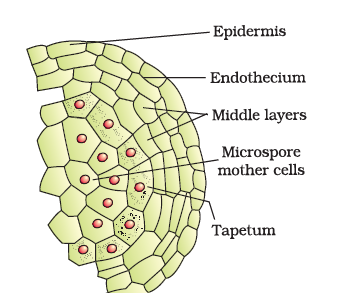
Endothecium performs the function of protection and help in dehiscence of anther to release the pollen.
Q5. Embryo sacs of some apomictic species appear normal but contain diploid cells. Suggest a suitable explanation for the condition.
Answer: It is true that many apomicts possess normal looking embryo sacs. The only possibility of the embryo sac possessing diploid cells is due to failure of meiotic division at the megaspore mother cell stage. Since, the megaspore mother cell has a diploid nucleus, if it undergoes mitosis instead of meiosis, all the resulting nuclei and cells will be diploid in nature.